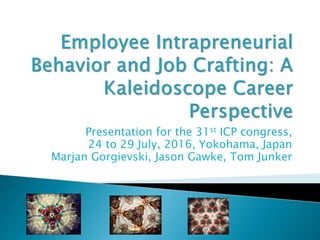2016 icp employee intrapreneurial behavior and job crafting
- 1. Presentation for the 31st ICP congress, 24 to 29 July, 2016, Yokohama, Japan Marjan Gorgievski, Jason Gawke, Tom Junker
- 2. ’üĮ Changes in the world of work have increased demands for self-direction and worker initiative (e.g., Crant, 2000; Grant & Parker, 2009; Sullivan & Baruch, 2009). ’üĮ This has led to an increased need to understand the how and why of pro-active worker behavior. ’üĮ This study aimed to understand the motives for and outcomes of pro-active work behavior (job crafting and employee intrapreneurship) from a kaleidoscope career perspective.
- 3. PA Work and P-E fit behavior Strategic and venturing behavior ŌĆ£self-initiated, anticipatory action that aims to change and improve the situation or oneself.ŌĆØ Parker & Collins, 2010, pp. 635
- 4. Basic assumption: Career patterns change throughout the life span, with the emphasis shifting between: Challenge ŌĆō seeking career advancement and personal growth through stimulating work experiences. Balance ŌĆō desire to balance work and private life. Authenticity ŌĆō need for work activities to be congruent with personal values and beliefs.
- 5. Based on the KCM we expect: H1 - Need for challenge and authenticity (not balance) predict pro-active work behavior (crafting challenge demands and resources and employee intrapreneurship) H2 - Corporate entrepreneurial behavior additionally predicts job crafting (more challenge demands and resources).
- 6. H3 - Crafting challenges, crafting resources and corporate entrepreneurial behavior predicts fulfillment of need for authenticity and need for challenge. H4 - Crafting challenge demands, crafting resources and corporate entrepreneurial behavior predicts work engagement
- 8. ’üĮ Longitudinal study with a 12 week time lag ’üĮ N = 641 civil servants, 59.8 % male, 80% higher educated (bachelor) Measures T1 and T2 ŌŚ” KCM needs (Maniero & Sullivan, 2005) ŌŚ” KCM Need fulfilment, developed for this study ŌŚ” Job crafting (Tims, Bakker & Derks, 2012) ŌŚ” Employee Intrapreneurship (Gawke, Gorgievski, Bakker, 2015) ŌŚ” Work engagement, 9 item version (Schaufeli, Bakker & Salanova, 2006) ’üĮ Method: SmartPLS
- 9. 1 2 3 4 5 6 7 8 9 10 11 12 13 14 15 16 17 18 19 1 gender 2 age 0,23 Time 1 3 Need for autonomy -0,01 -0,05 0,72 4 Need for balance -0,07 -0,13 0,28 0,81 5 Need for challenge -0,03 -0,12 0,37 0,21 0,77 6 autonomy fulfilment 0,06 -0,05 0,47 0,20 0,27 0,78 7 balance fulfilment 0,03 -0,08 0,12 0,45 0,13 0,45 0,86 8 challenge fulfilment 0,05 -0,03 0,11 0,13 0,37 0,59 0,36 0,81 9 crafting challenges -0,07 -0,16 0,33 0,03 0,54 0,19 0,01 0,17 0,77 10 crafting resources -0,05 -0,16 0,28 0,14 0,51 0,27 0,07 0,35 0,69 0,74 11 intrapreneurship 0,17 0,03 0,30 -0,02 0,42 0,19 -0,04 0,24 0,54 0,54 0,89 12 work engagement 0,06 0,04 0,14 0,01 0,33 0,46 0,17 0,54 0,33 0,42 0,29 0,92 Time 2 13 autonomy fulfilment 0,06 -0,08 0,31 0,14 0,20 0,64 0,35 0,46 0,14 0,24 0,17 0,41 0,76 14 balance fulfilment 0,01 -0,09 0,08 0,33 0,07 0,27 0,69 0,21 0,02 0,04 -0,04 0,10 0,38 0,85 15 challenge fulfilment 0,08 -0,07 0,09 0,11 0,31 0,49 0,30 0,72 0,18 0,32 0,24 0,50 0,59 0,30 0,81 16 crafting challenges -0,01 -0,17 0,29 0,03 0,54 0,17 0,02 0,16 0,73 0,56 0,50 0,23 0,17 0,05 0,20 0,76 17 crafting resources -0,02 -0,17 0,28 0,10 0,52 0,23 0,04 0,29 0,64 0,75 0,52 0,35 0,26 0,01 0,35 0,71 0,76 18 intrapreneurship 0,19 0,02 0,23 0,00 0,39 0,20 0,01 0,27 0,46 0,47 0,80 0,24 0,16 0,01 0,28 0,56 0,55 0,88 19 work engagement 0,04 0,03 0,11 -0,03 0,29 0,42 0,15 0,52 0,24 0,34 0,23 0,79 0,46 0,15 0,58 0,28 0,40 0,26 0,92 Career needs T1 Behaviour T1 H1 ’üŖ ? H2-4 ’üŖ ?
- 10. Need for balance Need for authenticity Need for Challenge Crafting resources Crafting Challenges Employee Intrapreneurship Crafting resources Crafting Challenges Employee intrapreneurship KCMNeeds Proactivework behavior Proactivework behavior Partial support Hypothesis 1, Need for challenge (not authenticity) predicts pro-active work behavior Full support Hypothesis 2, intrapreneurship predicts crafting resources and challenges ,07 (.03) ,15 (.03) ,20 (.03) ,14 (.03) ,12 (.03)
- 11. ’üĮ No vice versa. ’üĮ Proactive behavior did not predict need fulfilment nor work engagement. ’üĮ Only work engagement predicted KCM need fulfillment. Balance Fulfilment T1 Authenticity Fulfilment T1 Challenge Fulfilment T1 Work Engagement Work Engagement Balance Fulfilment T2 Authenticity Fulfilment T2 Challenge Fulfilment T2 KCMNeed fulfilment KCMNeed fulfilment ,15 (.04) ,15 (.04)
- 12. Wave 1 Wave 2 The engaged and challenge seeking intrapreneurŌĆ”.
- 13. ’üĮ Limiting factor: time frame. ŌŚ” Too long to capture relationships between behavior and work engagement? ŌŚ” To short to capture changes in employee intrapreneurship and need fulfilment? ’üĮ Could work engagement be a mediator? ’üĮ Self-reports: ŌŚ” Do other people agree with the subjective reports of employee behavior? ’üĮ Practical relevance KCM?
- 14. ’üĮ Limiting factor: time frame. ŌŚ” Too long to capture relationships between behavior and work engagement? ŌŚ” To short to capture changes in employee intrapreneurship and need fulfilment? ’üĮ Could work engagement be a mediator? ’üĮ Self-reports: ŌŚ” Do other people agree with the subjective reports of employee behavior? ’üĮ Practical relevance KCM? Thank you!














